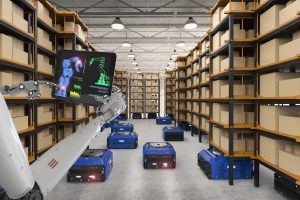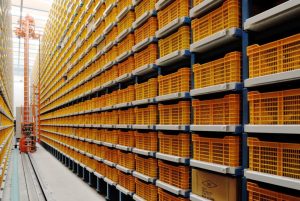As part of our Warehouse Automation series Harry Stafford, Consultant at BoxLogic, provides an overview of cube (sometimes referred to as ‘hive’) storage solutions.
In this post, Harry discusses a storage concept that is getting a lot of attention as it is central to the Ocado solution and is offered more widely by AutoStore. He outlines how it works, where it is used, in addition to the pros and cons of the technology.

Introduction
Cube/ Hive automation is a G2P (Goods-to-Person) solution that utilises ASRS (Automated Storage and Retrieval System) in a cubic format to handle items packed into uniformly sized totes while the operative remains at a handling station connected to the grid.

Solution Equipment
A cube storage solution comprises several key pieces of equipment.
Equipment | Description |
|---|---|
Totes | Totes are plastic containers for storing products within the system. The totes can also be fitted with dividers to segregate multiple SKUs being stored within the same tote. For the main solutions, totes can come in a range of heights, although they operate on the same footprint (i.e. length and width). Each tote is barcoded so that it can be traced throughout its handling journey. |
Storage Grid | The grid provides the structure for storage totes to be held and allow the robots to move around to access or putaway storage totes. Totes are stored in vertical ‘stacks’, which robots ‘dig’ through to get to the required tote. |
Robots | Robots run along the top, underneath, or around the side of the grid, depending on the specific solution. They are responsible for putting away totes in the storage grid or retrieving them for picking. Some totes may be dedicated to ‘digging’ while others focus on the transporting between the grid and the workstations. |
Workstations | Workstations are where human operatives, or sometimes robotic arms interact with the ASRS. It is at these locations where totes are presented to be filled with product or picked from to fulfil customer orders. The workstation is flexible in design and depends on how many orders are to be picked concurrently, how despatch cartons are supplied and taken away, whether pick-to-light technology is used to support greater pick rates and whether packing is conducted at the workstation. |
Control System | A control system is the brains and intelligence behind the solution, managing the order well and robots to maximise efficiency. The control system communicates with each robot to advise of traffic so other robots can take alternative routes. It connects to the warehouse management system to receive and confirm customer orders as well as inventory holding. |
Chargers | Chargers are installed in the solution to charge the batteries within the robots. The robots can be set rules to charge at certain levels or opportunity charge when they are not busy. They are key to maintaining uptime of the solution. |
How do Cube Storage Solutions Work?
A typical cube solution works as follows:
Decant
Goods are injected into the system via the workstations, where a human operative empties replenishment cartons into the storage locations on the presented rack. The operative interacts with a terminal at the workstation to scan products, providing traceability to the control system of which items are placed within each tote, or section of a tote if dividers are used.
Putaway
The robot conducts a putaway process whereby it picks up the tote from the decant workstation and it is placed in a tote stack with available capacity. Each tote stack works on a ‘LIFO’ (Last-In-First-Out) system so other totes may be placed in front of it, or the tote may be moved to another stack so another tote within the stack can be accessed.
Retrieval
The robot, or robots, will ‘dig’ through the stack of totes to access the required tote. The tote will be taken to straight to the workstation or buffered at an accessible point within the grid.
Picking
The picker will be presented with a tote by a robot at the workstation. They will interact with a computer terminal that directs them to the required storage location, if the tote is subdivided alongside the pick quantity and the ‘put’ container or location, which will group multiple items together of an order.
The configuration and number of orders in the put wall is customised for each operation. A single tote presentation may satisfy pick lines over multiple orders. Completed orders will be cleared from the put wall and directed towards packing or marshalling. Some operations may choose to pack at the workstation.
Where Can Cube Storage Solutions Be Used?
Cube solutions are suitable for any industry or sector which requires the storage of small goods that can be stored within a tote, whether this be vehicle parts, pharmaceuticals, garments, or groceries. They are particularly applicable to the ever-growing D2C ecommerce sector where single item picks are most prevalent. Complexity is introduced in operations that also include items that do not fit within a tote and therefore need to be consolidated post-pick.
These systems naturally operate an ABC profile where the fastest moving items typically sit at the most accessible locations with slower moving items falling to the back of the tote stack. As such, cube storage solutions work well with operations with standard pareto profiles. Flat pareto profiles mean that more robots are required to conduct the digging and retrieval process, reducing its efficiency.
Pros and Cons of Cube Storage Solutions
Cube solutions boast exceptionally storage density as no walkways or aisles are required. They offer high security, safety and sanitation as human interaction and access is limited to the handling stations. Goods-to-Person picking supports improved efficiency over manual solutions, and they are highly scalable. Operators can simply add more robots to deal with higher throughputs or more storage locations if storage requirements are increased.
The main drawback of cube solutions, in comparison to other solutions on the market, is the lack of accessibility to slower moving items at the back of the tote stacks. This can create issues for operations that require a rapid turnaround of orders, e.g. when a slow moving item is ordered just before the order cut off time and needs to be despatched within a short period after.
The industry leader of cube solutions, AutoStore, has a max storage height of circa 5.5 metres which means a significant amount of potentially unused space above the solution, however, the density offered is still comparable to other solutions that operate up to 12m. Newer solutions, like Jungheinrich’s PowerCube can operate at heights of up to 12 metres, offering even greater density, but again will sacrifice accessibility.
Comparable Technologies
Cube storage offers the greatest storage density available in operations of 12 metres or lower but depending on your operational requirements, other comparable solutions are available. AMR CTUs (or AMR Shuttles), Exotec can offer greater accessibility to totes at slightly reduced storage density. Shuttle ASRS solutions might be more appropriate for higher throughput solutions or where the building height is greater than 12 metres.
Summary
BoxLogic are leading warehouse automation consultants, and have a wealth of experience in warehouse design projects for a variety of cross-sector clients. From identifying suitable types of automation, analysing expected benefits and ROI timescales, through to shortlisting and suggesting vendors. Our independence means that we identify the most appropriate solution for you. If there is no case for automation, we will recommend a manual solution and help you design it.
BoxLogic is well positioned to assist you with your next Warehouse Automation project. Contact us to discuss your project today.



